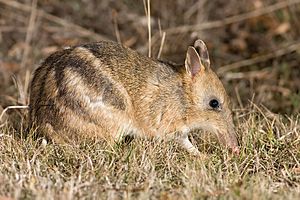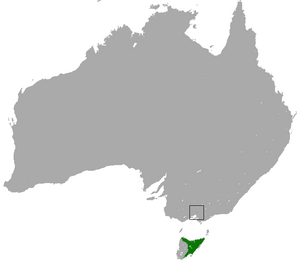Eastern barred bandicoot facts for kids
Quick facts for kids Eastern barred bandicoot |
|
|---|---|
 |
|
| Conservation status | |
| Scientific classification | |
| Genus: |
Perameles
|
| Species: |
gunnii
|
 |
|
| Eastern barred bandicoot range (green — native, pink — reintroduced as native population is extinct) |
|
The eastern barred bandicoot (Perameles gunnii) is a small, rabbit-sized marsupial that is active at night (this is called being nocturnal). It is found only in southeastern Australia, specifically on the island of Tasmania and in mainland Victoria. It is one of three types of bandicoot still alive in the Perameles group. You can tell it apart from the long-nosed bandicoot by the three or four dark stripes on its back.
This bandicoot is the only kind found in Tasmania, where it is quite common. However, the population in Victoria is in trouble. Many people are working hard to help it survive. Fun fact: this animal inspired the popular video game character Crash Bandicoot!
Contents
Eastern Barred Bandicoot: What It Looks Like
The eastern barred bandicoot weighs less than 2 kg (4.4 lb). It has a short tail and three to four white stripes across its back, near its rump. There are two separate groups of these bandicoots: one on mainland Australia and one in Tasmania. The Tasmanian bandicoots are a bit bigger. An adult in Victoria weighs about 750 grams, while one in Tasmania weighs about 1,000 grams.
These bandicoots usually live for only two to three years. They are not very social animals. Males have large areas where they live and only meet with females to mate.
Life Cycle and Habits
Eastern barred bandicoots are nocturnal, meaning they are active at night. They leave their nests at sunset to look for food. They eat many small creatures without backbones, like crickets, beetles, and earthworms. During the day, they rest in a nest made of grass. When they hunt for food, they use their long noses to dig deep into the soil. If they find something, they dig quickly to get it!
Reproduction
Female bandicoots have 8 nipples and can have up to 5 babies in one litter. On average, they have 2 to 3 young. Their pregnancy lasts only 12 days, which is one of the shortest pregnancies for any mammal! The babies are ready to stop drinking milk at 55 days old. They stay with their mother and learn to find food until they are about 86 days old. If conditions are good, a female can have up to five litters each year. However, they have fewer babies in summer and stop completely during dry periods.
Where Eastern Barred Bandicoots Live and Their Conservation Status
The eastern barred bandicoot used to live across the Basalt Plains of southwestern Victoria and in Tasmania. Sadly, the Victorian group is now critically endangered. This is because of animals like foxes and cats that were brought to Australia. Also, a lot of their land was cleared for farming.
Since 1989, people have tried to bring bandicoots back to eight different places where they used to live. Saving the eastern barred bandicoots in Victoria now depends on these programs. These programs involve breeding them in zoos and then releasing them into the wild. Key parts of this plan include keeping some bandicoots safe in captivity. They also do research to help more bandicoots survive after being released. Plus, they work to make more people aware of this rare marsupial and get their support.
Efforts to Save Them
In 1987, a plan was made to help the bandicoots. It suggested releasing them at Woodlands Historic Park, near Melbourne. In 1988, bandicoots were moved from the last wild group in Hamilton, Victoria, to breeding places at Woodlands. The babies born there were then released into a special 400-hectare area of the park. This area, called the Back Paddock, has a fence to keep out wild predators.
Unfortunately, the bandicoot groups at four of these sites are now gone. These include Floating Islands Nature Reserve and Lake Goldsmith Nature Reserve. The group at Woodlands Historic Park is almost gone. The group at Mooramong is shrinking. However, the groups at Hamilton Community Parklands and Mount Rothwell are growing! The last wild group, which lived along a creek in Hamilton, has also disappeared. It is thought that there are only about 150 eastern barred bandicoots left in Victoria.
The Tasmanian group (P. g. gunni) is also at risk, but not as much as the Victorian one. This is because Tasmania has many good places for them to live. Also, the island does not have the red fox, which is a big predator of the bandicoot. Eastern barred bandicoots have been successfully released on Phillip Island, French Island, and Churchill Island in Victoria's Westernport.
Recovery Efforts for the Eastern Barred Bandicoot
In Victoria, a special team called the Recovery Team works to save the Victorian bandicoot. This team includes people from government groups, non-profit organizations, and private conservation groups. They work together to plan and carry out actions to help the species. Some of the groups involved are Conservation Volunteers, Zoos Victoria, Parks Victoria www.parkweb.vic.gov.au, Mount Rothwell Biodiversity Interpretation Centre, and the University of Melbourne. Volunteers can also help through Conservation Volunteers' Wild Futures program.
One very helpful way to save the bandicoots is to build fences. These fences keep out animals that are not native to Australia and hunt bandicoots. These include wild cats and red foxes. These fences also help stop the spread of diseases among the few bandicoots that are left.
Eastern Barred Bandicoot: Family Tree
The eastern barred bandicoot is most closely related to other bandicoots in its group. Only two other species from this group are still alive today. These are the western barred bandicoot (Perameles bougainville) and the long-nosed bandicoot (Perameles nasuta). Another close relative, the desert bandicoot, is now extinct.
There are about 20 other bandicoots in the same family, called Peramelidae. They all have similar features like long, pointed noses and small ears. Bandicoots are also closely related to bilbies. They belong to the same larger group called Peramelemorphia. All these animals are part of the infraclass Marsupialia. This means they are marsupials, like koalas and kangaroos. Marsupials separated from other mammals about 100 million years ago.
All the animals in this group are native to Australia and New Guinea. However, scientists are not entirely sure how closely related this group is to other marsupials. Bandicoots have two features that give different clues about their evolution.
Evolutionary Clues
Bandicoots have three pairs of lower front teeth (incisors). This usually suggests they evolved from the Dasyuromorphia group, which includes meat-eating marsupials. However, the middle two toes on a bandicoot's foot are joined together, except for the claw. This is called syndactyly. This feature suggests they share a common ancestor with the Diprotodontia group, which includes kangaroos and koalas.
Scientists have theories to explain these clues. It's possible that the incisors in bandicoots and meat-eating marsupials developed separately. They look similar and do the same job, but the meat-eaters' teeth are much sharper. If this is true, then it makes sense that the joined toes (syndactyl feet) are a shared feature from a common ancestor with kangaroos and wombats. Syndactyly is very rare, so it's unlikely to have evolved twice in different groups. The feet of bandicoots and kangaroos are quite similar in structure. This suggests they have a more recent shared ancestor.
However, it is also possible that syndactyly evolved separately in different groups. In this case, bandicoots might be more closely related to animals like the Tasmanian devil and the numbat. This would mean their incisors are shared features from a common ancestor, and their joined hind feet are similar because they do the same job, not because they share a close ancestor.
Right now, scientific evidence from DNA does not fully support or disprove any of these theories. It is still not completely clear where the bandicoot fits exactly in the tree of life. But no matter what, it seems that the relationship between bandicoots and bilbies and other marsupial groups is a distant one.
Images for kids
- ARKive – images and movies of the Eastern barred bandicoot (Perameles gunnii)
See also
 In Spanish: Bandicut oriental para niños
In Spanish: Bandicut oriental para niños



